Categories: Electrician Secrets, Automata and RCD
Number of views: 7519
Comments on the article: 0
How to check the differential machine and RCD
Residual current circuit breakers residual current circuit breakers are designed to disconnect power when a leakage current occurs. This is often called differential protection. However, any switching device must be checked both for operation as such and for compliance with the rated parameters.
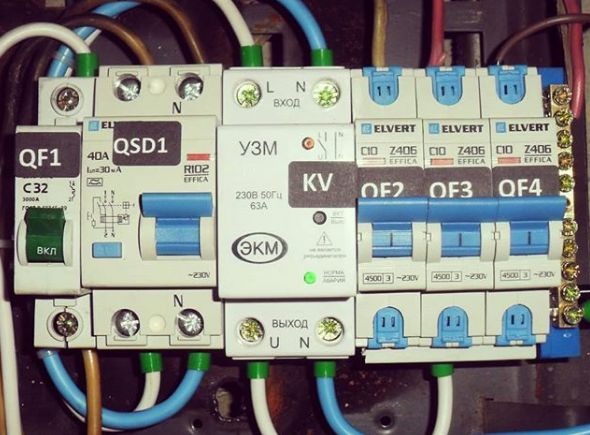
The principle of operation of UZO and difavtomat and their differences
Residual Current Device whether as they are called "RCDs" are triggered when the current difference between the poles. In simple terms, the principle of operation of these devices is to compare the current through phase and zero.
If the current through the phase is greater than zero, then part of it flowed in a different way, for example, insulation of the conductors is damaged or TEN struck and a current of a certain magnitude "flows" into the earth.
If the housing of the appliance is grounded - this situation is not too terrible and even with good grounding is not even dangerous, but if you have a two-wire power supply network without grounding - then if the potential hits the housing, it will not go anywhere with it. As a result of this, current will flow into the earth through your body when you touch the body with the exposed part of the body.
At best, you will feel tingling and pull your arm. In the worst case, the amount of current through your body may exceed the permissible and this will lead to death. RCDs happen electromechanical and electronic, in essence, the principle of operation is the same for them, only the system for working off the trip differs. In its simplest form, an electromechanical RCD contains a transformer, with its help, the magnitude of the current through one and the other pole is compared.
To distinguish electronic RCD from electromechanical, look at the circuit on its front panel.
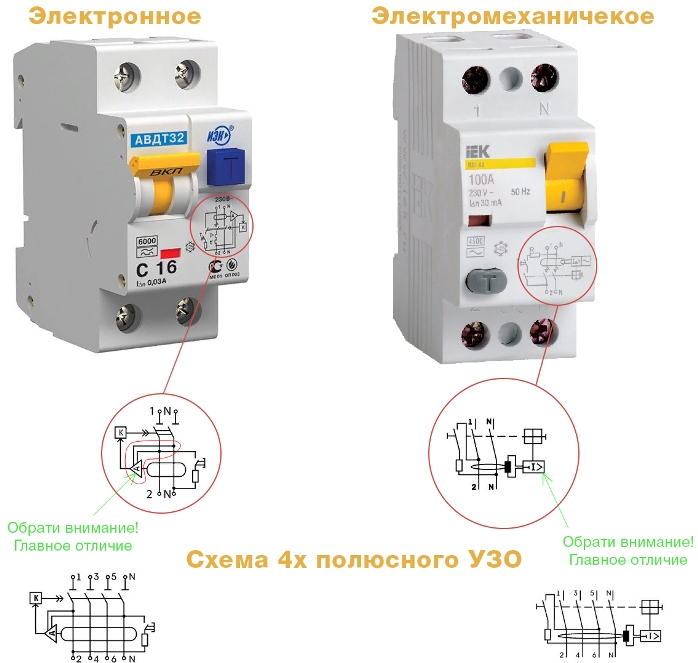
Important: The residual current device responds only to differential current. This means that the RCD does not protect the wiring from short circuit currents. Circuit breakers protect against short circuit. Difavtomat - This is a combined device, it works on high currents, like a circuit breaker, and on a differential current like an RCD. That is, in one case two switching protective devices are combined.
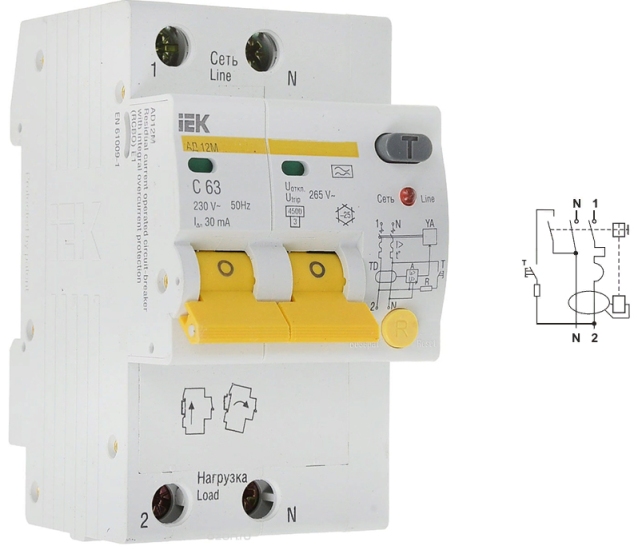
Verification Methods
As you may have already guessed, the technique for checking the operation of an RCD and a difavtomat for a leak is similar. On the front panel of one and the other device there is an on / off flag and a "TEST" button. According to PTEEP adj. 3, tab. 28, p. 28.7, it is necessary to check the operation with this button at least once a quarter (3 months).
Important:
The "TEST" button only checks the operation of the device by differential current or leakage current, but does not check the operation by exceeding the rated current of the difavtomat.
There are 5 main ways to check:
-
using the "TEST" button;
-
using a battery;
-
using a magnet;
-
resistor
-
specialized device.
Testing with the "TEST" button
When you press the button to test the operation of the RCD or the differential machine inside the device, a resistor is connected between the output phase contact and the incoming zero. Thus, the current through the phase wire becomes larger than the current through the neutral wire. If the device is serviceable, it will turn off. Therefore, such a check is possible only if the device is connected to the mains and power is supplied to it.
The circuit for checking an RCD or a difavtomat using this button is shown on the front panel of the device.
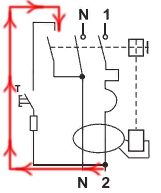
However, experts respond negatively to such a check, referring to the fact that the market is saturated with fakes and sometimes there are such instances of protective devices in which when you click on "TEST" the device works even if it is not connected to the network. This should not happen.
Battery and magnet check
Consider how to check an RCD or a difavtomat in a store without connecting the device to the mains. To do this, you need any battery, a new finger-type and two wires are suitable. You need to connect the wires to the battery, for this you can use an element of electrical tape, and connect their second ends to the terminals of one of the poles of the device under test. In this case, it must be cocked, that is, put the flag in the "ON" position.
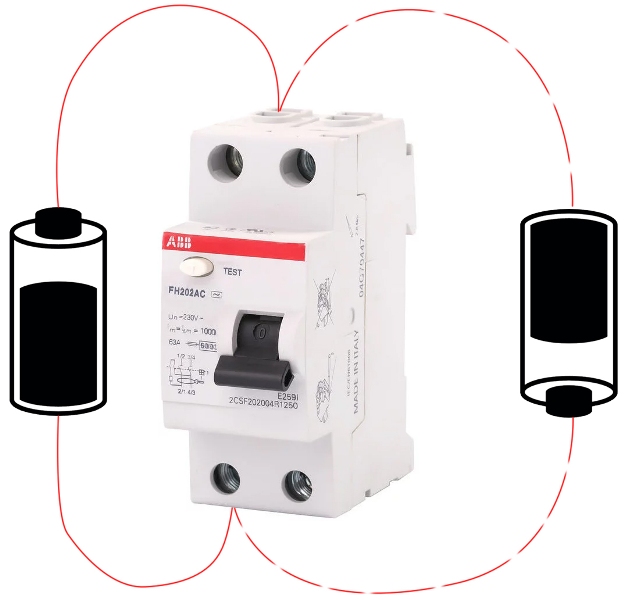
In this case, it is necessary to take into account the fact that RCDs or difratomata are arranged so that they operate on one of the half-waves. Those. polarity is important when testing. This means that if the device did not work with this method of verification, change the polarity; for this, simply swap the wires. If the device does not work at any polarity, it means it is electronic, not electromechanical!
Note: RCD type “A” works with any polarity, and type “AC” - only with a certain polarity - turn the battery over!
Using a magnet, you can also determine the health of an RCD or a difavtomat directly in the store. But this method only works for electromagnetic switches of differential current, devices with electronic filling will not work.
To do this, bring the magnet to one of the sides of the device under test. The checkbox should again be on (up). The magnetic field of the magnet will induce current in the winding of the measuring transformer, as a result of which the protection will work and the device will turn off.
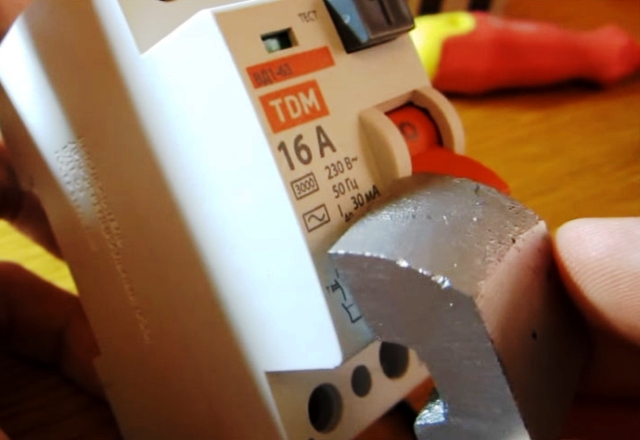
IMPORTANT:
I repeat, if the RCD is electronic - such a check will not work! For the operation of electronic RCDs and diflavtomats, it is necessary that power is connected (phase and zero).
Test with a resistor or bulb
Previous test options reflected only the protection performance and the response to the current difference as such. You could not determine how correctly the device works. At home, you can check the trip current, although not quite accurately.
First, calculate the resistor value for the value of the differential tripping current. For example, RCDs with a tripping current of 30 mA are very common, which means that we conditionally imagine that the network has 220 volts (measure the real value directly at the object where the device will be installed). So you need to take a resistor to:
220 / 0.030 = 7333.33 Ohms
The power on the resistor will be released briefly (about 6 watts), but nevertheless it will be better if you choose the most powerful resistor.
After that, we connect a resistor between the phase coming out and the zero coming to the device, as shown in the figure below.

The "TEST" button works in the same way.
IMPORTANT:
With this check, the RCD must be connected to the network.
If the device does not respond to the connection of the calculated resistor, then it is defective. You can also measure current with a multimeter. But since its course will be short-lived - you may not see its magnitude. For verification, you can assemble such a device, as in the video below, only its drawback is that the rated current is indicated.
You can of course measure the actual trip current of the RCD using an ammeter, but this requires a powerful rheostat. By smoothly reducing the resistance and measuring the current, you can determine at what current the trip occurred. In this case, it is better to use dial gauges, since most budget digital ones slowly update the readings of the measured value.
Conclusion
For accurate verification of RCDs and difratomata use special devices, for example:
-
Sonel MRP-200;
-
PZO-500;
-
PZO-500 Pro.
In addition to the leakage current, with the help of such devices it is possible to test devices at different phase angles and measure the response speed at different leakage currents.
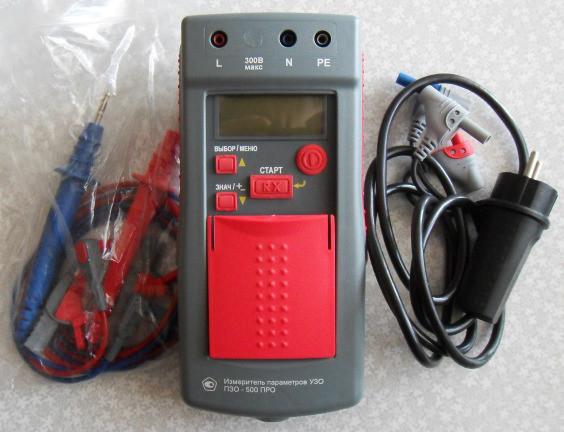
Buying them for private use is impractical, since they are expensive. When mounting an electrical panel at an object, you can turn to an electric laboratory for receiving such a service and filter out defective devices, if any.
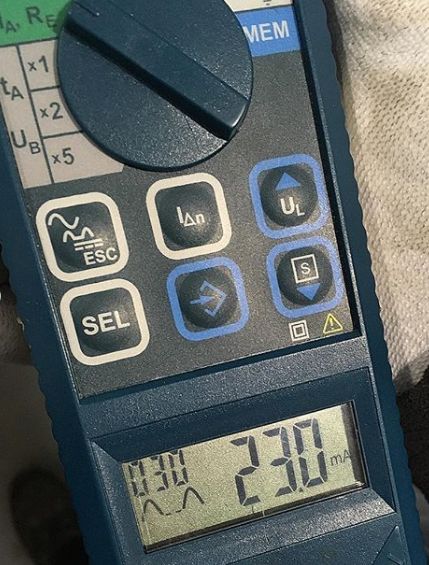

Standards: According to PTEEP, the testing of residual current circuit breakers should be carried out in accordance with the recommendations of the manufacturer. On average, they include checking the movement of the ON / OFF flag. It should clearly switch from one position to another, and also 1 time in the specified period to be tested by pressing the "TEST" button (but at least 1 time per quarter, according to the PTEEP). The tripping current must be at least 0.5In (for 30 mA RCDs it is 15 mA), other permissible values are described in GOST R50571.16-99.
See also at i.electricianexp.com
:
